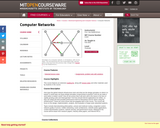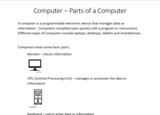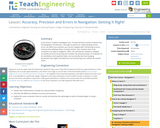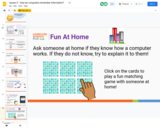
A presentation to help young students define and understand what an algorithm is.
- Subject:
- Applied Science
- Computer Science
- Material Type:
- Module
- Author:
- NYC Department of Education
- Date Added:
- 06/01/2021

A presentation to help young students define and understand what an algorithm is.

Topics on the engineering and analysis of network protocols and architecture, including: architectural principles for designing heterogeneous networks; congestion control; unicast and multicast routing; wireless and mobile networking; network quality of service; router design; network security; streaming and multicast applications; naming; content distribution; and peer-to-peer networking. Readings from original research papers, industry white papers, and Internet RFCs. Semester-long project and paper.

This resource defines a computer and its basic parts.It is provided as informational text.

This lesson should be used after students have completed the introductory Lego EV3 block building. This lesson wil help students get a better understanding of how to use input and output parameters. Students will explore and identify previously used software that uses block programming. Students will connect early interactions in Computer Science programming with the input and output parameters in Math. This lesson review input and output functions associated with the mechanics of a computer

In this lesson, students will investigate error. As shown in earlier activities from navigation lessons 1 through 3, without an understanding of how errors can affect your position, you cannot navigate well. Introducing accuracy and precision will develop these concepts further. Also, students will learn how computers can help in navigation. Often, the calculations needed to navigate accurately are time consuming and complex. By using the power of computers to do calculations and repetitive tasks, one can quickly see how changing parameters likes angles and distances and introducing errors will affect their overall result.

A presentation to help young students understand how computers remember and process information.

This course is an introduction to the consideration of technology as the outcome of particular technical, historical, cultural, and political efforts, especially in the United States during the 19th and 20th centuries. Topics include industrialization of production and consumption, development of engineering professions, the emergence of management and its role in shaping technological forms, the technological construction of gender roles, and the relationship between humans and machines.

An introduction to the ways computers have changed the world by solving problems